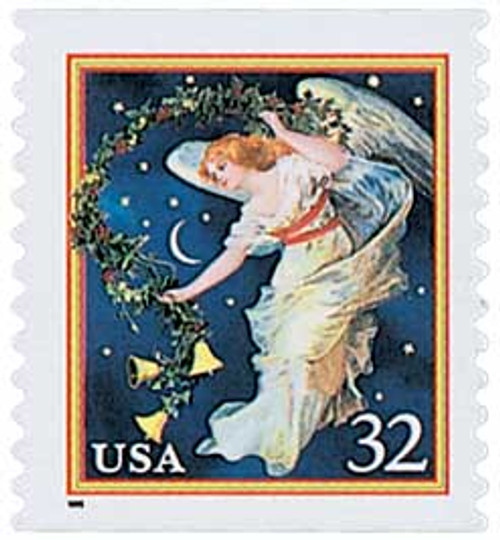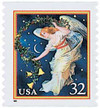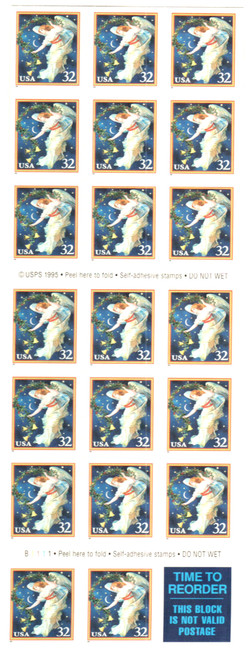
# 3018 - 1995 32c Traditional Christmas: Midnight Angel, coil
US #3018
1995 Midnight Angel
- Traditional Christmas stamp
- First self-adhesive Christmas stamp
- Issued as coil and booklet stamps
Category of Stamp: Commemorative
Set: Christmas
Value: 32¢, First-class mail rate
First Day of Issue: October 19, 1995
First Day City: Christmas, Florida
Quantity Issued: 1,980,000
Printed by: Banknote Corporation of America
Printing Method: Lithographed
Format: Rolls of 5,000
Perforations: Die Cut
Reason the stamp was issued: This stamp was issued to be used on mail during the 1995 holiday season. This stamp was issued in the self-adhesive format, which had become increasingly popular with the public by 1995. U.S. #3018 was only available from the center in Kansas City, Missouri.
About the stamp design: The image on this "Midnight Angel" stamp was taken from an antique greeting card, printed by an unknown company around 1910. However, the artist who created the illustration, Ellen H. Clapsaddle, is well known for the postcards she created for children. The image of the angel was reversed to face left, while the card’s image faced to the right.
First Day City: The First Day of Issue ceremony for this stamp, as well as the Children Sledding stamp, took place at Fort Christmas in the city of Christmas, Florida.
Unusual thing about this stamp: When the US Postal Service unveiled their 1995 stamp program at the end of the previous year, there was no plan for a Madonna and Child stamp. Instead, the traditional Christmas stamp would picture an angel. There was a loud outcry from the public and politicians, including then-President Bill Clinton. The USPS quickly reversed its decision.
In addition to producing a Madonna and Child stamp, the USPS decided to continue with plans for the angel stamp. The Victorian style used for the Midnight Angel stamp is similar to the style of the contemporary stamps.
About the Christmas series: By the early 1960s, the US Post Office was receiving 1,000 letters a year (for several years) asking for a Christmas-themed stamp to frank their holiday mail. The idea was approved and the US issued its first Christmas stamp on November 1, 1962.
The stamp was wildly popular, featuring popular holiday decorations of a wreath and candles. The Post Office Department had expected there would be a great demand for the issue, so they printed 350 million stamps – the largest print run for a special stamp up to that time. Those 350 million stamps sold out quickly, leading the Bureau of Engraving and Printing to produce more stamps – reaching over 860 million by the end of the year.
While the Christmas stamp was very popular, it wasn’t without its detractors. Some didn’t agree with the idea of the post office issuing a stamp honoring a religious holiday. Others wanted Christmas stamps that were more religious. The Post Office would continue to issue Christmas stamps in the coming years that featured the National Christmas Tree, seasonal plants, and an angel in 1965. The angel was considered less controversial because angels are included in many religions, not just Christianity.
In 1966, the Post Office came up with a plan to produce Christmas stamps utilizing classic paintings of the Madonna and Child. These stamps wouldn’t violate the separation of church and state because they were a celebration of culture. On November 1, 1966, they issued the first US Madonna and Child stamp in Christmas, Michigan. The stamp featured the 15th century painting, Madonna and Child with Angels, by Flemish painter Hans Memling.
That stamp was very popular and over 1.1 billion were printed. The same design was used again the following year, however, the 1967 stamp was larger and showed more of the painting. The stamp’s continued popularity led the Post Office to issue another traditional Christmas stamp in 1968, this time picturing the Angel Gabriel. For the 1969 issue, they reverted back to the non-religious theme, with a stamp picturing a painting called Winter Sunday in Norway, Maine.
The Post Office made a big change in 1970. To keep people in both camps happy, they issued one traditional Christmas stamp, picturing a classic painting of the Nativity, plus a block of four picturing Christmas toys. That decision proved popular and they have continued to issue stamps with both traditional and contemporary Christmas themes ever since.
US #3018
1995 Midnight Angel
- Traditional Christmas stamp
- First self-adhesive Christmas stamp
- Issued as coil and booklet stamps
Category of Stamp: Commemorative
Set: Christmas
Value: 32¢, First-class mail rate
First Day of Issue: October 19, 1995
First Day City: Christmas, Florida
Quantity Issued: 1,980,000
Printed by: Banknote Corporation of America
Printing Method: Lithographed
Format: Rolls of 5,000
Perforations: Die Cut
Reason the stamp was issued: This stamp was issued to be used on mail during the 1995 holiday season. This stamp was issued in the self-adhesive format, which had become increasingly popular with the public by 1995. U.S. #3018 was only available from the center in Kansas City, Missouri.
About the stamp design: The image on this "Midnight Angel" stamp was taken from an antique greeting card, printed by an unknown company around 1910. However, the artist who created the illustration, Ellen H. Clapsaddle, is well known for the postcards she created for children. The image of the angel was reversed to face left, while the card’s image faced to the right.
First Day City: The First Day of Issue ceremony for this stamp, as well as the Children Sledding stamp, took place at Fort Christmas in the city of Christmas, Florida.
Unusual thing about this stamp: When the US Postal Service unveiled their 1995 stamp program at the end of the previous year, there was no plan for a Madonna and Child stamp. Instead, the traditional Christmas stamp would picture an angel. There was a loud outcry from the public and politicians, including then-President Bill Clinton. The USPS quickly reversed its decision.
In addition to producing a Madonna and Child stamp, the USPS decided to continue with plans for the angel stamp. The Victorian style used for the Midnight Angel stamp is similar to the style of the contemporary stamps.
About the Christmas series: By the early 1960s, the US Post Office was receiving 1,000 letters a year (for several years) asking for a Christmas-themed stamp to frank their holiday mail. The idea was approved and the US issued its first Christmas stamp on November 1, 1962.
The stamp was wildly popular, featuring popular holiday decorations of a wreath and candles. The Post Office Department had expected there would be a great demand for the issue, so they printed 350 million stamps – the largest print run for a special stamp up to that time. Those 350 million stamps sold out quickly, leading the Bureau of Engraving and Printing to produce more stamps – reaching over 860 million by the end of the year.
While the Christmas stamp was very popular, it wasn’t without its detractors. Some didn’t agree with the idea of the post office issuing a stamp honoring a religious holiday. Others wanted Christmas stamps that were more religious. The Post Office would continue to issue Christmas stamps in the coming years that featured the National Christmas Tree, seasonal plants, and an angel in 1965. The angel was considered less controversial because angels are included in many religions, not just Christianity.
In 1966, the Post Office came up with a plan to produce Christmas stamps utilizing classic paintings of the Madonna and Child. These stamps wouldn’t violate the separation of church and state because they were a celebration of culture. On November 1, 1966, they issued the first US Madonna and Child stamp in Christmas, Michigan. The stamp featured the 15th century painting, Madonna and Child with Angels, by Flemish painter Hans Memling.
That stamp was very popular and over 1.1 billion were printed. The same design was used again the following year, however, the 1967 stamp was larger and showed more of the painting. The stamp’s continued popularity led the Post Office to issue another traditional Christmas stamp in 1968, this time picturing the Angel Gabriel. For the 1969 issue, they reverted back to the non-religious theme, with a stamp picturing a painting called Winter Sunday in Norway, Maine.
The Post Office made a big change in 1970. To keep people in both camps happy, they issued one traditional Christmas stamp, picturing a classic painting of the Nativity, plus a block of four picturing Christmas toys. That decision proved popular and they have continued to issue stamps with both traditional and contemporary Christmas themes ever since.















